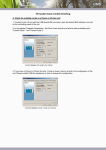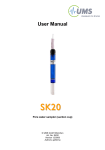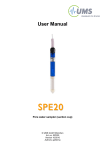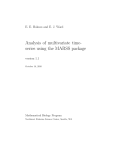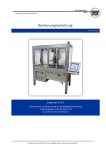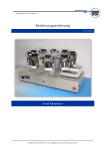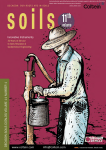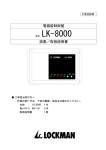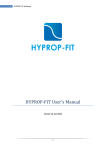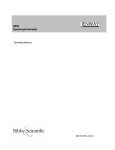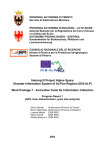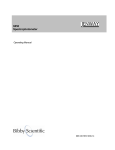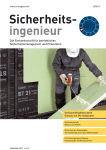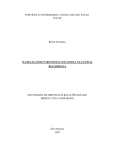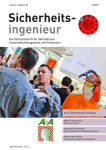Download manual of HYPROP - manuals.decagon.com
Transcript
User Manual
HYPROP
HYPROP system
Table of content
1
HYPROP system
1.1
1.2
1.3
1.4
1.5
1.6
5
Safety instructions and warnings
Content of delivery
Expression of thanks
Intended use
Guarantee
Important note
5
6
8
9
10
11
2
Process summary
12
3
Product description
13
3.1
3.2
3.2.1
3.2.2
3.2.3
3.2.4
3.2.5
3.3
3.4
4
System components
Sensor unit
Main body
Pressure transducers
Tensiometers
Temperature sensor
Plug connector
Sampling ring
Software tensioVIEW®
13
13
13
14
15
16
16
16
16
Get ready to start a measuring campaign
18
4.1
Soil samples
4.1.1
Soil Sampling
4.1.2
Saturate the samples
4.2
Filling
Important cautions
4.2.1
Refilling of the HYPROP
4.2.2
Degas ceramic tip and refill HYPROP shaft
4.2.3
Degas the sensor head
4.2.4
Reassemble the sensor unit
4.2.5
Check the HYPROP
4.3
Attach the sampling ring
19
19
19
21
21
24
24
27
30
32
33
5
35
Set-up the HYPROP
5.1
Connect the system components
5.1.1
Scale
5.2
Software tensioVIEW®
5.2.1
Menu
5.2.1.1 Find devices
5.2.1.2 Single device mode
5.2.1.3 Multiplexed devices mode
5.2.2
Device window
5.2.2.1 Properties
5.2.2.2 Configuration of a device
5.2.2.3 Configuration settings for HYPROP
5.2.3
Refilling window
5.2.4
Current readings
2/104
35
38
41
41
41
41
41
42
42
42
44
46
47
HYPROP system
5.2.5
Stored readings
5.3
Add the scale
47
48
6
50
Perform a measuring campaign
6.1
6.2
6.3
6.4
6.4.1
6.4.2
6.4.3
6.4.4
6.4.5
6.4.6
6.4.7
6.4.8
6.5
6.6
6.7
6.8
Starting conditions
Measuring campaign window
Configure the campaign
Perform the measurement
Single unit mode and multiplex device mode
Start of a measuring campaign
Constant starting conditions
Start a spontaneou measurement
Current status of the measurement
Measurements in the „Single device mode“
Multiplex devices mode
Interrupt a measuring campaign
Description of an ideal measured curve
Conclusion of a measurement
Remove the soil sample
Dry weight
50
52
53
54
54
54
54
55
55
56
57
58
59
60
62
65
7
Evaluation
66
8
Trouble shooting
67
9
Service and maintenance
69
9.1
9.1.1
9.1.2
9.1.3
9.1.4
9.2
9.3
9.4
Check the HYPROP
Check the Zero point
Check the Response
Calibration
Check the Offset
Cleaning
Storage
Change the O-ring on the HYPROP sensor unit
69
69
69
70
70
70
70
71
10 Theoretical basics
73
10.1 Evaporation method (overview)
10.2 Discrete data for retention and conductivity relation
10.3 Retention and conductivity functions
10.3.1 The van Genuchten/Mualem modell
10.3.2 The bimodal van Genuchten/Mualem Model
10.3.3 The Brooks and Corey Model
10.4 Optimization of the parameter
73
73
74
75
75
76
76
11 Additional notes
77
11.1 Extended measuring range
11.1.1 The bubble point of the porous cup
11.1.2 The vapour pressure of water
11.1.3 Boiling retardation:
11.2 Vapour pressure influence on pF/WC
77
77
77
78
79
3/104
HYPROP system
11.3
Osmotic effect
79
12 Appendix
80
12.1 Typical measurement curves
12.1.1 Sandy loam (Ls3)
12.1.2 Clayey silt (Ut3)
12.1.3 Slightly loamy Sand (Sl2)
12.1.4 Reiner Fein- bis Mittelsand (Ss)
12.2 Typical results for different soil
12.3 Parameter list
12.3.1 Input
12.3.2 Output
12.3.3 Parameter listing and describtion of the .csv table:
12.4 Units for soil water and matric potentials
12.5 Technical specifications
12.5.1 Wiring configuration
12.6 Accessories
12.6.1 HYPROP extension and Accessories
80
80
83
85
88
90
91
91
92
93
94
95
96
97
97
13 List of literature
99
14 Index
102
Your addressee at UMS
104
4/104
HYPROP system
1
HYPROP system
Laboratory evaporation method according to WIND/SCHINDLER for
the determination of unsaturated hydraulic conductivity and water
retention characteristics of soil samples.
1.1
Safety instructions and warnings
Electrical installations must comply with the safety and EMC
requirements of the country in which the system is to be used.
Please note that any damages caused by users are not covered by
warranty.
Tensiometers are instruments for measuring the soil water tension,
soil water pressure and soil temperature and are designed for this
purpose only.
Please be aware of the following warnings:
High pressure: The maximum non destructive pressure is
300 kPa = 3 bar = 3000 hPa. Higher pressure, which might occur
for example during insertion in wet clayey soils or during refilling
and reassembling, will damage the pressure transducer!
Ceramic cup: Do not touch the cup with your fingers. Grease,
sweat or soap residues will influence the ceramic's hydrophilic
performance.
Freezing: Tensiometers are filled with water and therefore are
sensitive to freezing! Protect Tensiometers from freezing at any
time. Never leave Tensiometers over night inside a cabin or car
when freezing temperatures might occur!
Do not use a sharp tool for cleaning the threads in the sensor unit.
Just rinse it with pure water from a spray bottle.
5/104
HYPROP system
1.2
Content of delivery
The delivery includes two bags and the package incl EG2200 Scale:
Bag 1: (black lock, similar for each HYPROP-E) is consisting of
(Figure 1-1) :
Sensor unit, set of Tensiometer shafts, 2 each 50 / 25 mm
acrylic attachment for sensor unit (3) Perforated saturation bowl
(4)
HYPROP connecting cable (5), 6 pcs. filter fabric, 15 cm x 15
cm (6), Silicone gasket (6)
®
tensioLINK T-piece junction plug(7) and silicone prot. caps (8)
1
3
2
5
8
7
Figure 1-1
6/104
4
6
HYPROP system
Bag 2 (white lock): service kit, which includes (Figure 1-2):
Bottle of deionised water (1)
Syringes incl: 2 reservoir syringes (2), - 2 vacuum syringes (with
red O-ring at tip) (3) 1 vacuum syringe with acrylic attachment (4)
incl. tube (12) and 1 droplet syringe (5)
Sampling ring with 2 plastic caps* (6)
Tensiometer auger (7) and auger adapter (11)
Cable set consisting of: Mains power device* (9), HYPROP
USB- converter (10)
®
tensioVIEW software on CD
5
3
4
2
7
12
11
10
8
6
1
Figure 1-2
7/104
9
HYPROP system
1.3
Expression of thanks
Dr. Uwe Schindler was able to considerably simplify the evaporation
method by WIND by analyzing the evaporation process and the
spatiotemporal decrease of water content inside the sample during
the evaporation process. The results of surveys of more than 2000
samples became part of German and international soil data bases
(HYPRES, UNSODA) and were basis of many scientific studies.
List of referring publications:
1.
2.
3.
4.
Schindler, U. (1980): Ein Schnellverfahren zur Messung der
Wasserleitfähigkeit
im
teilgesättigten
Boden
an
Stechzylinderproben. Arch. Acker- u. Pflanzenbau u. Bodenkd.,
Berlin 24, 1, 1-7.
Schindler, U.; Bohne, K. and R. Sauerbrey (1985): Comparison
of different measuring and calculating methods to quantify the
hydraulic conductivity of unsaturated soil. Z. Pflanzenernähr.
Bodenkd., 148, 607-617.
Schindler U., Thiere, J., Steidl, J. und L. Müller (2004):
Bodenhydrologische Kennwerte heterogener FlächeneinheitenMethodik der Ableitung und Anwendungsbeispiel für
Nordostdeutschland. Fachbeitrag des Landesumweltamtes.
H.87. Bodenschutz 2. Landesumweltamt Brandenburg.
Potsdam.
55
S.
http://www.brandenburg.de/cms/media.php/2320/lua_bd87.pdf
Schindler, U., Müller L. 2006. Simplifying the evaporation
method for quantifying soil hydraulic properties. J. of Plant
Nutrition and Soil Science. 169 (5). 169.623-629.
Mr. Andre Peters, in his dissertation at the Institute for Geoecology of
the Technical University Braunschweig, headed by Prof. Dr.
Wolfgang Durner, has scientifically examined the theoretical
principles of the calculation method and improved the method to be
more precise. Furthermore, he developed the software SHYPFIT 2.0
to adapt the retention and conductivity functions to the measured
data, and implemented it in the HYPROP calculation software.
The thesis is documented in following publications:
1. Peters, A., and W. Durner (2008): Simplified Evaporation Method
for Determining Soil Hydraulic Properties. Journal of Hydrology,
under review.
8/104
HYPROP system
2. Peters, A., and W. Durner (2007): Optimierung eines einfachen
Verdunstungsverfahrens zur Bestimmung bodenhydraulischer
Eigenschaften, Mitteilungen der Deutschen Bodenkundlichen
Gesellschaft, im Druck.
3. Peters, A., and W. Durner (2006a): Improved estimation of soil
water retention characteristics from hydrostatic column
experiments,
Water
Resource.
Res.,
42,
W11401,
doi:10.1029/2006WR004952.
4. Peters, A. und W. Durner (2006b), SHYPFIT 2.0 Users Manual,
Internal Report. Institut für Geoökologie, Technische Universität
Braunschweig.
5. Peters, A., and W. Durner (2005): Verbesserte Methode zur
Bestimmung
der
Retentionsfunktion
aus
statischen
Säulenexperimenten,
Mitteilungen
der
Deutschen
Bodenkundlichen Gesellschaft. 107, 83-84.
6. Peters, A., and W. Durner (2007): Optimierung eines einfachen
Verdunstungsverfahrens zur Bestimmung bodenhydraulischer
Eigenschaften, Tagung der Deutschen Bodenkundlichen
Gesellschaft,
Dresden,
2-.9.September
2007.
URL:
http://www.soil.tu-bs.de/pubs/poster/2007.Peters.Poster.DBG.pdf
.
Sincere thanks are given to them for their support in the
development and for the numerous theoretical discussions and
practical advice. This helped to turn the method into a reliable
system with both, high accuracy and repeatability and excellent user
friendliness.
The technical and scientific high-lights of the HYPROP system are
the interactive graphical menu, the automatic offset correction and
the fitting routines according to Peters and Durner (2006b). Thus,
your HYPROP system is an extraordinary high tech soil laboratory
system.
1.4
Intended use
The intended use of the HYPROP system is the measurement and
determination of water retention characteristics and unsaturated
hydraulic conductivity as a function of water tension or water content
in a soil sample.
9/104
HYPROP system
1.5
Guarantee
UMS gives a guarantee of 12 months against defects in manufacture
or materials used. The guarantee does not cover damage through
misuse or inexpert servicing or circumstances beyond our control.
The guarantee includes replacement or repair and packing but
excludes shipping expenses. Please contact UMS or our
representative before returning equipment. Place of fulfillment is
Munich, Gmunder Str. 37, Germany!
10/104
HYPROP system
1.6
Important note
This Manual describes the hardware functions, the set-up, how to
perform a measuring campaign, service and maintenance. The
calculation and fitting procedure settings and background is
described in a separate Manual, which will be installed with our new
HYPROP-FIT Software (see attached link below)
New release of the data evaluation and
hydraulic functions fitting software HYPROPFIT.
Download Software
The new software for evaluation of HYPROP measurements
can be downloaded here:
http://www.ums-muc.de/static/HYPROP-FIT.zip
11/104
Process summary
2
Process summary
1. Preparation of sample and hardware
1.1. Fill HYPROP sensor unit(s) and Tensiometer shafts
1.2. Take samples with soil sampling rings
1.3. Saturate the soil samples
1.4. Drill the holes for the Tensiometer shafts
1.5. Place the sampling ring on the sensor unit
1.6. Connect the sensor unit to the PC
1.7. Connect the scale to the PC
2. Configuration of the tensioVIEW software
2.1. Add the scale
2.2. Define your measuring campaign
2.3. Select file and sample name(s)
2.4. Optionally select units and intervals
2.5. Optionally enter initial water content or select „automatically“
2.6. Select model and soil type
3. Execute the measurement campaign
3.1. Start the measurement, data is stored from this point
3.2. Wait for constant starting conditions
3.3. Set the starting line as soon as tension readings are constant
3.4. Weigh the samples in intervals, every 12 to 48 hours depending
on soil type
3.5. When one of the Tensiometers runs dry make the final weighing
and stop the campaign
4. Evaluation of Data with Hyprop DES
(see pdf, link on page 10)
12/104
Product description
3
3.1
Product description
System components
A measuring system can include one or several HYPROP
assemblies (max. 20). A HYPROP assembly consists of a sensor
unit and a sampling ring with a soil sample which is placed on each
sensor unit. Sensor units are linked to a PC via the serial
®
tensioLINK bus.
In intervals each sensor unit with sampling ring is weighed on a
laboratory scale. The scale must have either a RS232 or USB
interface, and the scale type must be implemented in the software.
3.2
3.2.1
Sensor unit
Main body
The electronic components and pressure transducers are
incorporated in the main body of the sensor unit. The sensor unit is
splash water proof (IP65) and can be cleaned with water as long as
the plug cover is closed.
Fig 2: HYPROP
assembly
Figure 3-1
13/104
Product description
Sampling ring
Silicone gasket
Tensiometer shaft
for lower level incl.
ceramic tip
O-Ring, prevents
intrusion of soil
Tensiometer shaft
for upper level incl.
ceramic tip
O-Ring, seals
Tensiometers
Screw-in thread for the
shafts with pressure
transducer beneath
Temperature sensor
Fastener clip
Sensor unit
Fig. Figure
3: Sensor
3-2 unit
3.2.2
Pressure transducers
The internal pressure transducers measure the soil water tension in
the sample through the two shafts differentially against atmosphere.
14/104
Product description
3.2.3
Tensiometers
Tensiometers measure the soil water tension or the matric potential.
These Tensiometers have a measuring range of +100 kPa
(water pressure) to -85 kPa (water tension). With proper
filling the Tensiometers may work beyond the conventional
tension measuring range. If the soil gets too dry the
Tensiometer needs to be refilled (see chapter “Refilling”).
The soil water tension is conducted via the porous ceramic
tip to the water inside the shaft and measured as an
analogue signal by the pressure transducer.
The Tensiometer shafts are screwed into the transducer
openings in the sensor unit. Standard sampling rings can
Fig 3-3 easily be placed on the sensor unit so the Tensiometer
ceramic tips are positioned inside the soil sample. There is
one short and one long shaft to pick up the tension at two depths.
The Tensiometer shafts are one of the most sensitive parts of the
system. Always handle them with care.
To transfer the soil water tension as a negative pressure into the
Tensiometer, a semi-permeable diaphragm is required. This must
have good mechanical stability and water-permeability, but also have
gas impermeability.
The Tensiometer tip consists of porous ceramic Al2O3 sintered
material. The special manufacturing process guarantees
homogeneous porosity with good water conductivity and very high
firmness. Compared to conventional porous ceramics the tip is much
more durable.
The bubble point of a Tensiometer ceramic is about 800 kPa. If the
soil gets dryer than the bubble point, air passes through. Thus, the
negative pressure inside the cup decreases and the readings go
down to 0 kPa.
With these characteristics this material has outstanding suitability to
work as the semi permeable diaphragm for Tensiometers.
Be aware that the ceramic will dry out when it is exposed to air
uncovered. Always put on the rubber cap filled with some water.
15/104
Product description
3.2.4
Temperature sensor
A temperature probe sits inside the small stainless steel pin on the
sensor unit. It measures the temperature of the soil sample. Although
the temperature is not part of the measurement it is useful
information for reviewing the quality of a measuring campaign. The
sensor has a tolerance of 0.2 K at 10 °C.
3.2.5
Plug connector
The bus cable is connected to the plug on the side of the sensor unit.
As the plug is taken on and off
regularly during a measuring campaign
an easy-going push-pull plug is used.
A simple-to-open spring-loaded cover
protects the plug when no cable is
connected. Tightly close the plug cover
before cleaning the sensor unit.
Figure 3-4
Dirt water inside the plug opening will destroy the functionality of
the connector.
Do not twist the plug.
Make sure that the cover is closed tightly before cleaning.
3.3
Sampling ring
A soil sample is taken with a stainless-steel sampling ring which has
a volume of 250 ml. The sampling ring is placed on the sensor unit
and fastened with the two clips. A silicone gasket completely seals
the bottom of the soil sample.
3.4
Software tensioVIEW®
®
The HYPROP system is equipped with the tensioLINK measuring
bus.
16/104
Fig. 6: tensioVIEW
®
®
With tensioLINK
you
are able to create an
extended network. The
network is connected to
a
PC
with
the
®
USBtensioLINK
converter. The Windows
®
software tensioVIEW is
used for configuration of
the devices and to
visualize
data.
The
software
automatically
recognizes all connected
devices.
Figure 3-5
®
Additional functions are integrated in tensioVIEW for optimized
usage with HYPROP (see chapter ”Performing a measuring
campaign“.). The functions are activated whenever the bus
recognizes that a HYPROP unit is connected.
If a laboratory scale with serial RS232 or USB interface is used
®
readings are automatically taken and evaluated by the tensioVIEW
software.
17/104
Get ready to start a measuring campaign
4
Get ready to start a measuring
campaign
The following tools are required to prepare a HYPROP unit before a
measuring campaign:
-
Sampling ring, volume 250 ml
Perforated saturation bowl
A dish or bowl with minimum rim height 7 cm
Mesh fabric, 15 cm x 15 cm
Auger positioning tool
HYPROP auger
Pair of scissors*
Service case for Tensiometer refilling
* not included
Figure 4-1
18/104
Get ready to start a measuring campaign
4.1
4.1.1
Soil samples
Soil Sampling
Samples should be as fresh as possible. Please follow the guidelines
for taking soil samples (described in DIN 4021, “Exploration by
excavation and borings; sampling)
Following a short instruction for
soil sampling based on lecture
notes from Prof. Dr. W. Durner:
Uncover the preferred soil level.
This can be either vertical or
horizontal. Hammer in the ring
by using a proper knock-on
handle and a medium size
hammer. Hammer in straight
and avoid tilting the ring.
Figure 4-2
Carefully excavate the ring with
a knife or spatula. Now cut off the overlapping soil along the ring’s
rim with a very sharp knife - take care not to smear the pores. Cover
the samples with protective caps for transportation. In general a
minimum of 5 to 10 samples per soil level are taken to determine the
bulk density and the retention curve.
Weights of the sampling rings might vary. Therefore, it is essential
that the rings are specifically weighed.
4.1.2
Saturate the samples
Remove the protective cap from the upper side of the sample (the
side with the straight rim without cutting edge) and place the mesh
fabric on the sample.
Attach
the
perforated
saturation attachment to
clamp the cloth.
Turn around the sample and
remove the second plastic
cap.
Fill the dish with water and
place the sample in the dish,
standing on the perforated
attachment.
Figure 4-3
19/104
Get ready to start a measuring campaign
The water level should be
2 cm in the basket.
Please place the sample
ring incl. saturation bowl
in the basket.
The cutting edge shows
upwards, thus the sample
is saturated capillary from
the reverse side.
After 4-6 h fill new water
inside the basket ca. 1cm
below the upper rim of the
sampling ring.
Figure 4-4
Important note: Slightly lift up and tilt the sampling ring with
saturation attachment inside the water filled saturation bowl. This
prevents that air bubbles are trapped between soil sample and
mesh fabric. Do this carefully so no soil particles are flushed out.
The duration until the sample is saturated and all air is removed will
depend on the soil type. When saturated, the sample surface will
have a glossy appearance. Clayey soil will need the longest (several
days).
20/104
Get ready to start a measuring campaign
4.2
Filling
Important cautions
Caution: The Hyprop uses highly sensitive pressure transducers.
Improper
handling
can
cause
irreversible
damage!
Read the chapter about refilling in this manual first.
Be extremely cautious when
screwing in the filled
Tensiometer cups. The
pressure inside the cup will
rise abruptly and
exceedingly! Always
observe the pressure in the
online window of
tensioVIEW!
Screw in the shaft slowly,
make sure the pressure
always is below the yellow
range.
Read the complete chapter
about refilling in this manual!
21/104
Get ready to start a measuring campaign
Be cautious when pulling off
the tube as vacuum is
inside!
An abrupt negative pressure
change on the water column
might destroy the pressure
transducer.
Do not pull off the tube
rapidly. Allow the pressure
to be released through the
end of the tube or pull off
the tube slowly so the
pressure inside the refilling
adaptor will rise slowly.
Be cautious when tapping
off air bubbles!
Do not knock the sensor
head too hard when under
pressure. Any impact of the
water column might destroy
the pressure transducer.
After finishing the degassing
it is important to remove the
tube by pressing down the
blue ring on the tube
connector. Do not pull out
the tube with force as this
might cause leakage of the
connector.
22/104
Get ready to start a measuring campaign
Before starting and after every completed measuring campaign (the
sample is dried out) the Tensiometers need to be filled or refilled
bubble free with deionised and degassed water. We recommend
degassing and refilling the HYPROP-Tensiometers after every
completed measurement campaign. If the measurement is stopped
before the bubble point of the Tensiometers are reached they can be
reused, provided the ceramic is kept moist (plug on the rubber cap
filled with some water).
Two spare Teniometer cups are supplied. Always keep them moist,
because then the degassing and refilling will be quicker.
Keep the ceramic moist when not in use by covering them with the
water filled rubber cap.
Ceramic tip: Do not touch the tip with your fingers. Grease, sweat
or soap residues will influence the ceramic's hydrophilic
performance.
The used Vacuum pump should be able to evacuate 2 kPa closed
to vacuum
The HYPROP-service kit or a vacuum system and a PC/Laptop with
®
tensioVIEW software are required for filling or refilling.
23/104
Get ready to start a measuring campaign
4.2.1
Refilling of the HYPROP
This chapter describes the refilling using a vacuum pump and
manual refilling using the tools of the HYPROP service kit.
The procedure requires 4 steps, which will be discussed in detail
later in the chapter:
Degas ceramic cup and shaft
Degas the sensor unit
Reassemble
Check the result
4.2.2
Degas ceramic tip and refill HYPROP shaft
If the tip is completely dry just put the empty shaft in a beaker with
de-ionized or distilled water (1,5 cm level) and leave it overnight.
HYPROP shafts should
never be filled from the
inside. To avoid that air is
trapped inside the ceramic
the water must flow in one
direction only from the
outside into the interior.
Keep parts clean so there
will be no leaking when
vacuum is applied.
Figure 4-5
24/104
Get ready to start a measuring campaign
Refilling with a Vacuum pump:
Connect rubber tubes to the shafts. Connect the tubes to a vacuum
bottle, and the vacuum bottle to the pump.
Start the pump and evacuate the system for at least 30 minutes and
switch off the pump for 1h. The vacuum drops down slowly, air
bubbles become smaller and can ascend. Repeat this procedure
approximately three times. When water (circa 10 ml) was drawn
through both ceramic tips they are filled.
Figure 4-6
25/104
Get ready to start a measuring campaign
Manually Refilling (incl. delivery):
Alternatively, take the reservoir syringe, fill it with completely
1
degassed water and take care to avoid bubbles in front of the
ceramic. Fill the shaft with water and plug the vacuum syringe filled
with ¼ deionized degased water completely over the thread. Pull it,
until both snappers are locked. Now, the water from the reservoir
syringe is drawn through the ceramic tip into the vacuum syringe.
When approximately 10 ml are flushed through the ceramic the
HYPROP shaft is filled.
Figure 4-7
1
Push out all air from the syringe. Now plug the end of the tube with your finger and
pull up the syringe. This creates vacuum inside the syringe and dissolved gas is
released. Rotate the still evacuated syringe to collect all bubbles from the wall of the
syringe. Hold the syringe upright and slide in the piston. Unblock the tube and push
out all air. Repeat this procedure until no bubbles are produced anymore.
26/104
Get ready to start a measuring campaign
4.2.3
Degas the sensor head
Avoid that the plug connector gets in contact with water.
Take care that the piston never recoils abruptly as this might
damage the pressure transducer (max. 3 bar)!
Please note: new vent cock assembled to the acrylic attachement of
the sensor head .
Figure 4-4 vent cock vertically: closed to ambient air
Figure 4-5 vent cock horizontally: open to ambient air, ventilation of
the sensorhead, but closed to vacuum pump.
Figure 4-8
Figure 4-9
27/104
Get ready to start a measuring campaign
Please fill the two threads
with
degased
water
carefully with the droplet
syringe
Figure 4-10
and fill up the bottom of
the sensor head until the
upper edge.
Figure 4-11
28/104
Get ready to start a measuring campaign
Filling with vacuum pump:
Place the acrylic sensor head attachment onto the sensor head. The
sensor head should sit firmly on the O-Ring. Fill up the acrylic
attachment with deionised water using the droplet syringe up to 1 cm
above the upper edge of the sensor head and connect the tube to
the acrylic sensor head attachement and the vacuum pump.
It is important to know that the vacuum is not applied abruptly. This
can be done very easily with the vent cock. (from open position
(Figure 4-9) to closed position (Figure 4-8))
Manually Refilling:
Take the syringe that belongs to the sensor unit attachment. Draw up
15 ml of water.
Degas the water as described
before and push out all air from
the syringe.
Place the acrylic sensor head
attachment onto the sensor
head. The sensor head should sit
firmly on the O-Ring. Fill up the
acrylic attachment with deionised
water using the droplet syringe
completelly full. (see Fig. 4-8).
Fill the tube with water.
Attach the tube, the vacuum
syringe
and
the
acrylic
attachement
Draw the syringe up until the
black spacer snaps in. Air
bubbles will assemble inside the
Figure 4-12
syringe. To avoid damaging the
pressure transducer, please securely hold the piston so it will not
suddenly recoil. Release the spacers and allow the piston to return
slowly. Only water should flow back into the acrylic attachment. Take
off the tube and push the assembled air out of the syringe. Reattach
the tube and draw the syringe up again until the spacers snap in
(repeat this procedure 3 times. The water now is being degassed.)
We recommend controlling the quality of the vacuum by observing
the refilling window in tensioVIEW
29/104
Get ready to start a measuring campaign
4.2.4
Reassemble the sensor unit
When screwing in the Tensiometer shaft into the thread of the
sensor head it is very important to monitor the pressure in the
®
refilling window in tensioVIEW .
The pressure sensor diaphragm is inside the small hole (ca. 2
mm) on the pressure sensor unit. It is very sensitive and must
never be touched! It can be destroyed even by slightest contact (e.
g. with a needle).
No contamination should get on sealing and gasket.
Please connect the HYPROP cable and the USB cable to the
®.
sensorhead and start the refilling window in tensioVIEW The
pressure signal should be very closed to zero.
Push the silicone cap (or tube) over the shafts to protect the ceramic,
please don´t touch the ceramic with
your fingers!
Add a drop of water on top of the
shaft with the droplet syringe, so the
meniscus is convex (see Figure 4-9)
Each hole on the sensor unit is
marked by a groove. The long shaft
is inserted where the long groove is,
and the short shaft where the short
groove is.
Figure 4-13
30/104
Get ready to start a measuring campaign
Carefully screw the shaft into the
sensor unit. While screwing (ca 8
turns)
in the Tensiometer shaft
the pressure must not exceed 1
bar (burst pressure = 3 bar). In
case the pressure rises to high,
stop the turning in and wait until
the pressure has dropped. You will
clearly notice the point when the
shaft hits the O-ring inside the
sensor unit. From this point do only
another quarter turn!
(1)
(2)
Figure 4-14
On the sensor unit push an O-ring
(1) over each of the shafts (2) to the
very bottom. The rings will keep out
dirt once the Tensiometer shafts
are installed. Place a water filled
silikon tube on the ceramic tip. It is
very important that the ceramic is
always wet.
Repeat the same procedure with
the second HYPROP shaft.
Figure 4-15
31/104
Get ready to start a measuring campaign
4.2.5
Check the HYPROP
Please start again the refilling window.
To check the Zero point, please put a droplet of water onto the
ceramic tip. The values should be around 0 +/- 3 hPa (0,3 kPa)
Wrap a dry paper towel around one ceramic tip to create a
momentary dry ceramic surface. Now create airflow around the
ceramic cup, e. g. by waving a sheet of paper. The reading should
rise to -800 hPa (-80 kPa) within seconds. If this is the case, the
Tensiometer is filled correctly. Do the same with the second tip.
To find out the maximum measuring range of the Tensiometers take
a bottle filled with water and hold the ceramic tip into the headspace
of the bottle. When you move the ceramic away from the water
surface the air gets dryer and the suction rises.
Hold the ceramic close to the water surface so the tension reading
will rise slowly. Depending on the filling quality the value will reach
-85 to -450 kPa. Then, the value will rapidly drop to the vapor
pressure (around -90 kPa depending on the altitude). Now
immediately put some water on the ceramic and cover the ceramic
with the protective rubber cap which should be halfway filled with
water. It will take one day until the Tensiometer will reach its initial
value.
32/104
Get ready to start a measuring campaign
4.3
Attach the sampling ring
Take the saturated soil sample out of the saturation dish. Place the
auger positioning tool on the sampling ring as shown in the picture..
Insert the auger into each opening
and drill a hole in 3 steps (to avoid
compressing the soil). Drill as far as
the auger will go. Rotate the auger
while pulling it out of the sample.
Then, you will have 2 holes in the
sample, each with the proper depth.
With a pen make a mark on the side
of the sampling ring where the
deeper hole is (see Figure 4-12).
Then you know the correct position
when placing the sample on the
sensor unit
Figure 4-16
To avoid that air will be pressed
inside
the
sample
it
is
recommended to fill up the holes
with water. (see Figure 4-17 ).
The sample now is ready for
attaching the sensor unit.
Wipe off the ring surface after
having drilled the holes.
Figure 4-17
Watch your mark. The long shaft must be inserted into the deeper
hole. Keep the ceramic tips wet!
If the soil sample swelled up during saturation the overlapping soil
must be cut off before attaching the sensor unit.
33/104
Get ready to start a measuring campaign
Remove the protetion tube from the ceramic tip. Place the silicone
gasket on the bottom of the sensor head (mud protection).
Turn the sensor unit up side down
and carefully place it on the soil
sample
by
inserting
the
Tensiometer shafts into the drilled
holes. Please take care that no air
gaps and soil compression will
happen.
Now turn the assembly and remove
saturation bowl and cloth. Close the
clips to fix sampling ring and sensor
unit.
Figure 4-18
Figure 4-19
Figure 4-20
34/104
Set-up the HYPROP
5
Set-up the HYPROP
In the next step please place the sensor head on the tared scale and
plug in the cables.
Figure 5-1
5.1
Connect the system components
®
The next step is to connect the components with tensioLINK .
Up to 20 sensor units can be linked to a PC at the same time with
the supplied bus cables and distributors.
Above (Figure 5-1) the sensor unit is directly connected to the PC
with the HYPROP USB-converter. The internal power supply of the
USB-converter is capable of powering a single sensor unit. (please
be aware to set the PC to constant power mode)
35/104
Set-up the HYPROP
Figure 5-2
In the multi device mode connect each sensor unit to a T-piece plug
with a HYPROP connecting cable. Sensor units can be connected in
any order as the software recognizes the position of any sensor unit
automatically.
Finally connect the main power supply unit to the plug of the last Tpiece plug and the HYPROP USB converter to a free USB port on
your PC. The internal power supply of the USB-converter is capable
of powering a single sensor unit. As soon as 2 or more sensor units
are connected the USB-power supply is not sufficient. Therefore, the
main power supply unit should always be connected.
36/104
Set-up the HYPROP
In the single device mode the HYPROP assembly remains on the
scale and the USB-cable is connected all the time. Therefore, it is
important to stabilize the USB-cable. A proper stabilization for the
USB-cable is required. Even smallest movements of the cable can
cause erroneous measurements. (see more next chapter)
Figure 5-3
37/104
Set-up the HYPROP
5.1.1
Scale
A laboratory scale with interface is required. If the type of scale is not
in the following list, the scale is not supported and has to be send in
to UMS (incl. manual and interface cable).
Supported scales:
Kern EG2200 (recommended)
Kern EW3000
Kern 572
CHYO MK2000B
Mettler Toledo SICS
Mettler Toledo PM2000
COBOS COBOS-CB Complet
If the scale has a serial RS232 interface connect it to a free COMport on your PC. You can use a RS232-USB-converter if no COMport is available on your PC. Please carefully follow the instructions
for the RS232-USB-converter.
The set-up of the scale in tensioVIEW® is described in chapter 5.3
„Add the Scale“
Figure 5-4
38/104
Set-up the HYPROP
Please note the following requirements for the operation of the scale
(also see 6.1 Starting conditions p 50):
1. The scale should be placed on a vibration-free work table.
2. The work table should only be used for the HYPROP
measurement.
3. The scale must be levelled out. Most scales have a bubble-level.
4. Since the Earth's gravity varies at each location the balance has
to be calibrated before the initial operation and every time the
balance is relocated. A periodical recalibration is recommended.
Use a standard weight of accuracy class M1. Please read and
follow the instructions in the manual of the balance. The
recommended scale Kern EG 2200 has an internal precision
weight, thus the accuracy of the balance can be checked at any
time and adjusted.
5. The weight, marked on the samping rings, relates to a gravity of
9,802 ms-2.
The gravity mainly depends on the latitude
9,780(0°) -9,833 (90°) ms-2.
6. Cable fixation
To avoid errors the HYPROP cable must be fixed. Mount the
HYPROP sensor cable as shown in the picture below. Clip the
cable into the cable clips. The cable should be put on the scale
and tared to “0”
Figure 5-5
39/104
Set-up the HYPROP
Figure 5-6
Cable length between plug and upper cable clip should be about 15
cm.
Cable length of the loop between both cable clips should be about 20
cm.
If you don´t have this clips please ask us for the accessory kit (incl
Application Note) to fix the cable. It is free of charge.
40/104
Set-up the HYPROP
5.2
5.2.1
Software tensioVIEW®
Menu
®
tensioVIEW has simple, mostly self-explaining menus for read-out
and configuration of tensioLINK devices.
®
After starting tensioVIEW the display is more or less blank, most
functions are not activated.
5.2.1.1 Find devices
If one or more sensors are connected via the USB-converter
they can be found by pressing the “magnifying glass” button.
®
tensioVIEW offers two options for searching:
5.2.1.2 Single device mode
®
tensioVIEW expects that only one device is connected which
will be found very quickly. This mode is not functional if more
than one device is connected!
5.2.1.3 Multiplexed devices mode
®
tensioVIEW is able to run up to 20 HYPROP sensor units
connected to the bus within 8 seconds, but only if each device
is already personalized with an individual bus identification address.
If two or more devices have an identical address, none of them will
be found.
All devices found will be displayed in the left section in a directory
tree. Same types of devices will be grouped in one directory.
41/104
Set-up the HYPROP
Double-click on the device
Figure 5-7
5.2.2
Device window
Detected devices will be displayed with their programmed names.
Press the + symbol to see what readings parameter are available.
Double-click on the name to open a menu window where all
specifications and functions of this device are displayed. Depending
on the type, different registries are available. The first shows an
overview of the current settings and information about address
number or error messages.
5.2.2.1 Properties
Gives an overview about the sensor head’s basic properties and is
only informative. You cannot edit the properties in this window.
5.2.2.2 Configuration of a device
Select the tab "Configuration“ for viewing and changing the
programmed settings of the device.
42/104
Set-up the HYPROP
Depending on the authorization status, only parameters that can be
edited are shown. To store a changed parameter in the device it has
to be sent to the device by pressing the "Upload“ button. A message
confirming the successful configuration will be displayed.
Configuration changes are effective immediately.
Figure 5-8
43/104
Set-up the HYPROP
5.2.2.3 Configuration settings for HYPROP
Those settings which are editable only for Power users are marked
with an asterisk *.
Parameters with related functions are bundled in one folder.
tensioLINK
Bus number
®
tensioLINK bus number of the device
Sub address
®
tensioLINK sub address of the device
Explanation:
®
tensioLINK uses two types of address for each device, the bus
address and the sub address. The reason for this is that is there
might be sensors installed at the same spot, but with different
measuring depths (for example multi-level probes). In this case, the
sub address defines the depth starting with 1 for the highest sensor.
Furthermore, the sub address could be used to combine groups of
sensors, for example of one measuring site.
In general the required identification for a device is always the bus
number. If more than 32 devices are connected to the bus the sub
address is counted up. The allowed numbers for the bus address are
1 to 32 and for the sub address 1 to 8.
The default value for both bus and sub address is 0. With more than
one device connected individual addresses have to be declared.
Device Info
Name
Individually editable name of the Tensiometer in ASCII. Maximum
length 12 digits
Measure head net weight
is the net weight of the sensor head incl. Tensiometer shafts and
silicone disc.
* User rights are selected in the bottom status line. Select between „Public“
(limited rights) und „Power“ (extended rights). The software needs to be
restarted when this setting is changed.
44/104
Set-up the HYPROP
Soil volume
Volume of the soil sample in the sampling ring excluding the
Tensiometer shafts’ volume.
Soil column height
Height of the soil column in mm (height of sampling ring).
Depth lower tens
Protruding length of the lower shaft.
Depth upper tens
Protruding length of the upper shaft.
Data logger
Interval
the logging interval of the internal data logger
Overwrite old values
Overwrites old values (if you select „on“) if the memory is full
Sensor measuring
Continuous measuring
Activate the quick updating of readings to receive the HYPROP
readings instantly, for example during a refilling procedure.
Measurements are taken in intervals of 50 ms. Note the rise in power
consumption and that the reaction to serial commands might be
slowed down. The setting "Measuring interval“ is deactivated during
this mode..
Measuring interval
This is the standard interval in which sensor measurements are
refreshed and available on the analogue lines.
Enable filter
Activate the anti-flicker-filter. This avoids that the digit continuously
jumps up and down. When activated the resolution is reduced for
one digit.
45/104
Set-up the HYPROP
5.2.3
Refilling window
This function is required when the HYPROP sensor head needs to
be refilled or during assembly of sensor head and Tensiometer
shafts (strictly recommended!!).
When the Tensiometer shafts are screwed back into the sensor
unit the pressure reading must be checked at any time to avoid
that excess pressure destroys the pressure transducer. Stop or
slow down if the pressure rises to much. Please read the chapter
4.2 ”Refilling“ for more details.
Figure 5-9
46/104
Set-up the HYPROP
5.2.4
Current readings
In this window you can display current values of the Tension Bottom
, Tension top and Temperature, depending on the Parameter
Interval.
5.2.5
Stored readings
In this window you can download stored readings and delete stored
readings, if logged data is available!
47/104
Set-up the HYPROP
5.3
Add the scale
Before you can start a measuring campaign the scale needs to be
added to the system. As scales have different specifications no
automatic search is implemented in the program. Only scales
supplied by UMS are pre-set.
There are two ways to add a new scale:
1. Click the right mouse button on HYPROP in the parent directory
to open the “Add“ and “Add HYPROP device“ window. Click on
„Add new Scales“.
2. Select the button in the menu <Devices>
device“ ...
Figure 5-10
48/104
<Add>
<Add new
Set-up the HYPROP
Select the scale type, for example “Kern EG2200“, the interface and the
connection parameters. Then click on the Measure-Button. If a
connection is established „zero“ is displayed for both status and
reading. Click “OK“ to select the scale.
Now the new device is shown in the explorer window.
Figure 5-11
If you click on “Scale“ in the explorer window the current readings
are shown.
49/104
Perform a measuring campaign
6
Perform a measuring campaign
Definition: a measuring campaign comprises the set-up
configuration, tension readings, weight readings and the evaluation
of one HYPROP assembly or of all assemblies measured at the
same time. This information is stored in one file for further use.
Familiarise yourself with the functions of tensioVIEW
start a measuring campaign.
®
before you
The starting conditions for a campaign are extremely important
Always power a laptop with a mains power unit, not just only by
battery.
It is extremely important that the cable is not moved during a
measurement campaign. Securely fix the cable as even a breeze
can move a dangling cable causing variance in the measurement.
Avoid leaving water drops on the fastener clips.
6.1
Starting conditions
The following conditions must be fulfilled before a measurement can
be started:
1. The initial water content of the
completely saturated sample is
estimated. It can be calculated if
the soil type is definitely known
2. The sample must be protected
from direct sunlight, air currents
or
extreme
temperature
changes.
Figure 6-1
50/104
Perform a measuring campaign
3. The scale should be placed on a vibration-free work table. The
work table should not be used for other purposes during a
HYPROP measurement.
4. During a single mode measurement we strictly recommend to fix
the cable of the sensor unit.
5. The scale must be levelled out. Most scales have a bubble level.
6. Set the energy manager of your laptop to non-stop operation.
Open the energy option manager and set „Power-down“ and
„Stand-by“ to „Never“. If the laptop powers down or goes to the
stand-by mode no readings are stored.
51/104
Perform a measuring campaign
6.2
Measuring campaign window
There are two ways to open the measuring campaign window.
1. In the menu bar select <Tools> <HYPROP Measuring
campaign>
2. Click this button:
Figure 6-2
52/104
Perform a measuring campaign
6.3
Configure the campaign
Open the measuring campaign window to configure the system.
Enter file name and directory where you want to store the measuring
campaign:
Under <General parameters> enter the starting time of the campaign
and the intervals when to weigh the samples (fig. below)). Select
<Single device mode> if the campaign only includes one assembly.
Higher frequency means: a
measuring interval of 1
minute at the beginning of
the measurement
In the units menu select the units for tension, conductivity and matric
potential. Select either logarithmic or linear display.
In the <Devices> window the device name and serial number is
displayed automatically.
Soil sampling ring weight (default 201g), and sample name need to
be entered.
53/104
Perform a measuring campaign
6.4
6.4.1
Perform the measurement
Single unit mode and multiplex device mode
In general there are two modes, the single unit mode and the
multiplex devices mode. The following table shows the differences.
Single unit mode
Sensor unit
Symbol
1
Weighing
remains on the scale
continuously
Measuring time
the selected
measuring time is
also the weighing
interval
6.4.2
Multiplex device
mode
2-20
you are asked to
place each unit on
the scale according
to the measuring
cycle
you set the time
separately
Start of a measuring campaign
Click the button „Start Campaign“ to start the
measuring campaign. The intervals entered in
the configuration are assumed.
6.4.3
Constant starting conditions
When you set the start line there must be constant starting
conditions. This means that the tension values are constantly
horizontal for a certain time period (preparation of the sample and
hardware see chapter 6.1 ).
54/104
Perform a measuring campaign
6.4.4
Start a spontaneou measurement
In the function window you can optionally click on <measuring> to
start a measurement spontaneously (out of the constant
measurement).
6.4.5
Current status of the measurement
In the left upper window (”Current status“) the current readings are
displayed.
Anytime you can stop the campaign, change the interval or restart
the campaign. The logging is continuously, starts and stops are
marked with a dotted line in the graphs. The upper graph shows the
tensions, the lower graph the weight.
The readings are displayed in a table on the right side of the graphs.
55/104
Perform a measuring campaign
6.4.6
Measurements in the „Single device mode“
Select “Single device mode” under “General Parameters” in the
configuration window. Set up the parameters as described in
the previous chapters. In the single device mode only one measuring
interval is entered which is used for both tension and temperature
measurement.
Start the measuring campaign and do a zero set as described in
chapter ”Zero Set”.
Figure 6-3
56/104
Perform a measuring campaign
Figure 6-4
6.4.7
Multiplex devices mode
®
Connect all devices with tensioLINK to the HYPROP main
unit. Click on “Multiplex devices mode” to start a scan. Note
that a different tensioLINK address is given to each device (see
chapter ”Configuration Settings”).
Enter an interval for the Tensiometer measurements, for example 10
minutes.
The interval for weighing can be different than the one for tension
measurement. As the weight of the sample changes slowly it is
recommendable to choose a larger interval (depending on the soil
type). For cohesive soils (clayey soil) we recommend an interval of 3
weight measurements per day. For less cohesive soils (sandy soil) 1
weight measurement per day is sufficient.
At the end of each interval you are asked to measure the samples.
To do so unplug the LEMO plug from the sensor unit. The system
57/104
Perform a measuring campaign
will automatically recognize which sample is put on the scale. The
number of samples is limited to 20.
A new menu opens on the screen showing information about the
status and the routine of the weighing.
Follow the given instructions (fig. 49).
Figure 6-5
6.4.8
Interrupt a measuring campaign
A measurement can be interrupted temporarily as the readings are
stored. Reload them with „Open project“ in the main tensioVIEW
menu (also for example after a power breakdown).
58/104
Perform a measuring campaign
6.5
Description of an ideal measured curve
Each measurement proceeds in 3 phases (provided that
Tensiometers and sensor unit have an excellent filling).
Phase 1: Boiling retardation
The Tensiometer readings rise without flattening into the range of
boiling retardation (beyond -85 kPa).
Phase 2: Consolidation
Water vapor accumulates. The Tensiometer reading abruptly drops
down to the boiling point of approximately -85 kPa and remains
constant at this level (dot and dash line in figure ....).
Phase 3: Air entry
The Tensiometer reading abruptly drops to 0 kPa as air enters the
ceramic cup. The bubbling point of this ceramic is about -880 kPa
(close to pF 4). This value is also used for the evaluation (see
chapter “7 Evaluation”).
Phase 1
2
Phase 3
Figure 6-6: the different phases of the upper Tensiometer (left curve)
59/104
Perform a measuring campaign
6.6
Conclusion of a measurement
A measurement campaign can be concluded if the 1st Tensiometer
(T1) drops to 0 kPa (bubble point) and the 2nd Tensiometer is in
Phase 1 (dash and dot line in Figure 6-7).
Ab hier Abbruch
T1
Figure 6-7
60/104
T2
Perform a measuring campaign
If the 1st Tensiometer (T1) drops to 0 kPa (air entry) and the 2nd
Tensiometer is still in Phase 2 no averaging is possible. In this case
you must wait until the 2nd Tensiometer (T2) reaches the bubble
point. Then, the measurement can be concluded (see Figure 6-8).
Ab hier Abbruch
T1
T2
Figure 6-8
If an extraordinary error occurs the measurement can be stopped
any time.
Exemplary measurements for various soils are shown in the
appendix.
61/104
Perform a measuring campaign
6.7
Remove the soil sample
1. Hold the whole assembly over a bowl or dish to assure that no soil
material is lost.
2. Unlock the fastener clips. Gently pull on the soil sampling ring to
take off the ring from the sensor head.
Figure 6-9
If the soil is too dry and if it is not possible to dismantle the HYPROP
with the soil (e.g. clay) it is recommended to take the sample in water
to get saturated over night.
62/104
Perform a measuring campaign
3. Please clean the sample ring and the silicon disc above the bowl.
It is more easy to take a brush (see pictures below)
Figure 6-10
Abbildung
6-5
Abbildung
Figure 6-11
6-4
4. Clean the sensorhead with water (wash bottle) and a dustfree
tissue over the bowl.
63/104
Perform a measuring campaign
5. In the end you should clean the sensor head and the tensiometer
under running water (see picture below)
Figure 6-12
Please unscrew the both HYPROP shafts only when the sensor
head is completely clean.
64/104
Perform a measuring campaign
6.8
Dry weight
Empty the soil sample into a bowl with known weight. Dry it in a
drying oven at 105°C for 24 hours and then weigh it again.
Figure 6-13
The „Soil dry weight“ will be used to calculate the actual water
content and has to be entered later in the HYPROP FIT Software.
65/104
Evaluation
7
Evaluation
Evaluate a measurement with the HYPROP-FIT software.
To execute the evaluation in the correct order proceed
through the menus „Information“, „Messung“, „Auswertung“, „Fitting“
and „Export“ step-by-step.
All options of the software as well as background information about
evaluation and data fitting can be found in the extensive online
manual of HYPROP-FIT (click on ‘Help’ in the status line).
66/104
Trouble shooting
8
Trouble shooting
Problem
1. It is not possible to achieve a
bubble free filling.
Possible cause and solution
If the tip is completely dry just put
the empty shaft in a beaker with
deionised
or
distilled
water
overnight.
2. The Tensiometer readings only
rise very slowly
a)
3. The Tensiometer reaches a
maximum of -50 kPa, then the
reading drops
4. The Tensiometer shows readings
beyond vacuum (-100 kPa)
5. The curve cannot be fitted
6. The recording of readings has
stopped
7. Tensiometer reach only -50 to -70
kPa, then readings drop slowly
Could depend on the soil type:
for example sand has a poor
conductivity. Thus, the curve of
the readings will be flatter than
for example in a clayey soil.
b) The Tensiometer is not
sufficiently filled and degassed
(see 1)
c) A leakage has occurred (see 3)
The Tensiometer is not sufficiently
filled and degassed (see 1).
The shaft was not properly screwed
onto the pressure body, and the Oring is not tight. Reassemble the
shaft.
This is no error but a particular
feature of the miniature
Tensiometer. Due to boiling
retardation it is possible that the T5
might reach values up to -140 kPa.
Please check fig. 51 for this effect.
a) Reset start and stop line as
described in the chapter „End of
the measuring campaign“.
b) The curve progression is not
consistently rising, eventually it
is necessary to start a new
measurement (causes see
point 3)
Check the USB connections
In the power management menu of
your PC or laptop disable the power
down and select non-stop operation.
The Tensiometer was not
sufficiently filled. A bubble
assembles inside the ceramic part
67/104
Trouble shooting
8. At the beginning the lower
Tensiometer surpasses the upper
one which would indicate a negative
conductivity
9.No sensor units are found in the
multiplex device mode
and interrupts the water contact
(see point 3)
This is caused by inaccuracy of the
sensors. Execute the “Zero offset“ to
compensate the water column shift.
Eventually set the starting point to a
later point.
Disconnect all sensor units. Connect
just one unit and start a search in
the single device mode. Check for
each sensor unit that no address is
given twice (see pages 42/43). In
case, change the address as
described in this manual. Sensor
units can only be found if addresses
are unique.
68/104
Service and maintenance
9
9.1
Service and maintenance
Check the HYPROP
1. First check if the Tensiometers of the HYPROP need to be refilled
(recommended always at initial use and after a complete
measurement campaign):
Connect the sensor unit with adapter cable and USB-converter to
®
your PC and start tensioVIEW .
2. Click on the magnifying glass symbol to search for devices.
Select the sensor unit you want to check.
3. Click on “Refilling” to open the
“Refilling window”.
9.1.1
Check the Zero point
If the tips are moist both readings
should be around 0 hPa (between 5 and + 5 hPa).
If you have not done the zero set
(compensation of water column) the
values are higher due to the shaft
length.
9.1.2
Check the Response
Wrap a dry paper towel around one ceramic tip to create a
momentary dry ceramic surface. Now create an air current around
the ceramic cup, e. g. by waving a sheet of paper. The reading
should rise to -80 kPa within seconds. If this is the case, the
Tensiometer is filled correctly. If not, the Tensiometers needs to be
refilled.
Do the same with the second tip.
69/104
Service and maintenance
9.1.3
Calibration
When delivered the HYPROP transducers (Tensiometers) are
calibrated with an offset of 0 kPa (when in horizontal position) and a
linear response. The offset of the pressure transducer has a minimal
drift over the years. Therefore, we recommend to check the
HYPROP sensor unit once a year and re-calibrate them every two
years.
Return the HYPROP sensor unit to UMS for recalibration If
necessary.
9.1.4
Check the Offset
Screw off the Tensiometer shafts. Carefully blow out remaining water
®
from the shaft drillings. Connect the sensor unit to tensioVIEW and
continuously observe the readings.
Wait until the readings are stable. The readings should be between
-0.2 kPa and +0.2 kPa. If the readings are beyond this range a recalibration might be necessary.
9.2
Cleaning
The sensor unit is rated IP65 and can be cleaned under running
water, but pay attention that the cover of the plug connector is
closed.
Clean ceramic and shaft only with a moist towel. If the ceramic is
clogged it may be flushed with Rehalon®.
If the pores are clogged with clay particles saturate the ceramic and
then polish the ceramic surface with a wetted, waterproof sandpaper
(grain size 150...240).
9.3
Storage
If the HYPROP should not be used for a year or more empty shaft
and sensor head to avoid algae growth. Store both in a dry place.
70/104
Service and maintenance
9.4
Change the O-ring on the HYPROP sensor unit
After many refilling procedures, but also if the O-ring is squeezed too
hard with the shaft, the O-ring can be worn out, and is not sealing
anymore.
You will notice this if the Tensiometer does not reach the boiling
point anymore (i.e. close to 90 kPa), or the tension curve gets flat or
drops abruptly at a point far below the boiling point (see figure
below).
71/104
Service and maintenance
For replacing the O-ring a pair of fine pointed tweezers is required.
CAUTION: Do not insert the tip into the boring as you might punch
the membrane of the pressure transducer..
How to proceed:
Pierce into the O-ring to pick it
up and remove it.
Spare O-rings can be find in the
service case.
Grab the replacement O-ring,
but now not pierce it. Carefully
insert the ring into the round
groove inside the boring.
If the ring does not slip into the
groove carefully screw in the
shaft to push the ring into its
position.
72/104
Theoretical basics
10
Theoretical basics
10.1 Evaporation method (overview)
In a soil sampling ring two Tensiometers, comparable to the T5
model, are installed in two depths (z1 and z2). The middle between
the sensing tips of the Tensiometers is the centre of the soil sample.
The sample is saturated, closed on the bottom and placed on a
scale. The upper side of the sample is open to atmosphere so the
soil moisture can evaporate. With the soil water tension [kPa] the
average matric potential and the hydraulic gradient is calculated. The
mass difference, measured by the scale, is used to calculate the
volumetric water content and the water’s flow rate.
A measuring campaign will last until one of the Tensiometers runs
dry or the mass changes become marginal. Then, the remaining
moisture content is determined by oven drying the sample at 105°C
for 24 hours. With these values the retention curve and the
unsaturated conductivity is extrapolated.
10.2 Discrete data for retention and conductivity
relation
i
i
i
At different points of time t the water tensions h1 and h2 (in hPa) of
both depths are measured as well as the weight of the sample (in
3
grams cm ). The analytic procedure is based on the assumption
that water tension and water content distribute linear through the
column, and that water tension and sample weight changes are
linear between two evaluation points.
The initial water content is determined from the total loss of water (i.
e. evaporation + water loss by oven drying).
i
The average water content
, derived from initial water content and
h i give a discrete value
i
(h i ) of the retention function at any time t i .
loss of weight, and the medial water tension
For the calculation of the conductivity function it is assumed that
between two time points
ti
1
and
t i the water flow through the cross
73/104
Theoretical basics
section situated exactly between both Tensiometers (and therefore
exactly at column centre) is
qi
½ Vi
ti A .
V i is the water loss in cm³ determined by weight changes, t i is
the interval between two evaluation points, and A the cross section
area (in cm²) of the column.
The data for the hydraulic conductivity function are determined by
inverting the Darcy-Equation:
K i (h i )
h
i
i 1
i
i
h2 1 h1
¼ h1
evaluation points, with
-1
cm h ).
h
i
i 1
½ (h2
qi
.
hi / z 1
h2i is the medial water tension between two
K i as the related hydraulic conductivity (in
i 1
i
i
h1 ) (h2 h1 ) is the medial difference of the water
tension between both Tensiometers, whereas
distance between both Tensiometers (in cm).
z
z2
z1 is the
Unreliable K (h) data sets close to saturation are filtered depending
to the measuring accuracy of the Tensiometers.
To get a sufficient number of data points for the hydraulic function
even with relatively long intervals, both the tension curve and the
weight curve between two evaluation points are interpolated with
hermitian splines (Peters and Durner, 2008). On this basis relatively
short evaluation intervals are achieved.
10.3 Retention and conductivity functions
Normally hydraulic characteristics are described by parametric
functions for (h) and K (h) .
With HYPROP three models can be chosen. These models can be
adapted to measure data via a robust and non-linear optimizing
procedure.
74/104
Theoretical basics
10.3.1 The van Genuchten/Mualem modell
With this model the effective saturation S e
and
r
s
r
the unsaturated conductivity K in relation to the matric potential h are
predetermined by the following equation formula (van Genuchten,
1980):
(1 ( h ) n )1 / n
S e ( h)
K ( h)
K s (1 ( h ) n )
(1 / n 1)
Here the residual water content
1
1 ( h )n 1 1 ( h )n
r,
1/ n 1 2
the water content at saturation
-1
s,
the inverse value of the bubble point potential
[cm ] and the
pore size distribution n [-] are the fitting parameters for the retention
[-] and the
function. Furthermore, the tortuosity parameter
K s are fitted to get the conductivity function.
saturated conductivity
10.3.2 The bimodal van Genuchten/Mualem Model
This model suggested by Durner (1994) describes the retention and
conductivity function by overlapping of two individual van Genuchtenfunctions (Priesack and Durner, 2006).
2
S e ( h)
j
n
(1 (
j
1/ n j 1
h) j )
j 1
2
K ( h) = K s
2
w j [1 (
n
j
1/ n j 1
wj
j
{1 (
j h)
nj 1
[1 (
n
2
1/ n j 1
j
j h) ]
j =1
h) j ]
2
j =1
,
wj
j
j =1
The j are indexes for the parameters of each van Genuchten
function, and w j are the weights of both partial functions. The
following restriction applies:
0
wj
1 and
75/104
wj
}
1.
Theoretical basics
10.3.3 The Brooks and Corey Model
In the Brooks & Corey model the retention and conductivity function
are defined as (Brooks and Corey, 1964):
S e ( h)
K ( h)
for h
for h
1
h
Ks
Ks
h
2/
2
1
1
for h
1
for h
1
[-] and
[-] are two fitting parameters which correspond to the
pore size distribution, respectively with the tortuosity.
10.4 Optimization of the parameter
The (h) - and K (h) functions are adapted simultaneously to the
and n
data points. This is essential as distinct parameters (i. e.
at van Genuchten/Mualem) influence the shape of both functions.
The adaption is accomplished by a non-linear regression under
minimization of the sum of all assessed squares of the distance
between data points and model forecast. However, the assumption
that the water content is spread out linear over the column is not
always fulfilled in coarse pored or structured soil. Therefore, the so
called “integral fit” is applied for the adaption of the retention function
to avoid an systematic error (Peters and Durner, 2006). For details of
the fitting procedure and data assessment please refer to Peters and
Durner (2007, 2008).
Please find a reference list in the appendix!
76/104
Additional notes
11
11.1
Additional notes
Extended measuring range
The extent of the measuring range of a Tensiometer is influenced by
3 factors:
1. The bubble point
2. The vapour pressure (boiling point)
3. The boiling retardation
11.1.1 The bubble point of the porous cup
The bubble point of a porous, hydrophilic structure is specified by the
wetting angle and the pore size. The cups used for UMS
Tensiometers have a bubble point far beyond the measuring range
(8.8 bar). Therefore, the bubble point has no limiting influence.
11.1.2 The vapour pressure of water
At a temperature of 20°C the vapour pressure of water is 2.3 kPa
against vacuum. With an atmospheric pressure of 100 kPa and at
20°C the water will start to boil, or vaporize, as soon as the pressure
drops below 2.3 kPa against vacuum, i. e. 97.7 kPa pressure
difference to an atmospheric pressure of 100 kPa - the Tensiometer
drops out.
The measuring range (at 100 kPa/20°C) is limited to -97.7 kPa.
Atmospheric pressures announced by meteorological services are
always related to sea level. Thus, the true pressure in a height of 500
meters over sea level is for example only 94.2 kPa although 100 kPa
are announced. Then, the measuring range at this height (at 20°C) is
even limited to -91.9 kPa.
If the soil gets drier than the maximum possible measuring range the
reading will remain at this value and then drop gradually towards
zero. If the soil gets as dry as the bubble point a spontaneous
equalisation with the atmospheric pressure occurs. Air enters the cup
and the reading will rapidly go to zero.
77/104
Additional notes
True pressure in heights over sea level at an atmospheric
pressure related to sea level as published by meteorological
services
Height over sea
Atmospheric
Max. measuring
level (meter)
pressure (kPa)
range at 20°C (kPa)
0
101.3
-99.0
500
95.5
-93.2
1000
89.9
- 87.6
1500
84.6
- 82.3
2000
79.5
-77.2
2500
74.5
-72.2
3000
70.1
-67.8
11.1.3 Boiling retardation:
Water needs a nucleation site to boil. As our Tensiometers have
polished surfaces and a gas-free filling the so called boiling
retardation occurs – the Tensiometer keeps on measuring beyond
the boiling point. To achieve this shafts and sensor unit must have
an absolutely bubble free filling.
Some Tensiometer cups can go down to -250 kPa before they run
dry, occasionally even a range of -450 kPa is achievable. As this is
exceptional there is no guarantee for this measuring range.
For HYPROP measurements this means that a measuring campaign
should be continued as long as the Tensiometers keep on
functioning (unless the 8.8 bar range is irrelevant).
It is possible to get further information from the known bubble point
which is 8.8 bar for the HYPROP cups. The moment the tension
reading rapidly drops to zero the soil has a tension of -880 kPa (+/20 kPa). Therefore, it is recommendable to continue with the
measurement until the tension reading is 0 kPa. (see publication: U.
Schindler, JPNSS, The evaporation method - Extended
measurement range of soil hydraulic properties using the air-entry
pressure of the ceramic cup).
78/104
Additional notes
11.2 Vapour pressure influence on pF/WC
If the temperature of a soil with a constant water content rises from
20°C to 25°C the soil water tension is reduced by about 0,85 kPa
due to the increased vapour pressure which antagonizes the water
tension.
Temperature
in °C
Pressure
change per
Kelvin in [hPa]
4
10
16
20
25
30
50
70
0,6
0,9
1,2
1,5
1,9
2,5
7,2
14
11.3 Osmotic effect
The ceramic has a pore size of r = 0,3 m and therefore cannot block
ions. Thus, an influence of osmosis on the measurements is
negligible because ion concentration differences are equalized
quickly. If the T5 cup is dipped into a saturated NaCl solution the
reading will be 1 kPa for a short moment, then it will drop to 0 kPa
again.
79/104
Appendix
12
Appendix
12.1
Typical measurement curves
Following typical curves were kindly provided by Prof. Dr. Wolfgang
Durner.
12.1.1 Sandy loam (Ls3)
Site: Wolfenbüttel; Soil type: Slightly sandy loam. Ls3 (S 35%, U 48%, T 17%) ;
Measurements in Winter 2011 "Geoökologische Labormethoden 2011", TU
Braunschweig. Evaporation: 2,75 mm/d.
Temperatur: 21°C
80/104
Appendix
Description of the measuring process
The measurement process is typical of a clay with wide pore size
distribution
The water tensions rise almost two days continuously, but at a
moderate slope. This reflects large pore fraction in clay of nearly
10%
From about 50 hPa (pF 1.7), the tensiometers are far enough
away to allow for the determination of hydraulic conductivities.
After two days the tensiometers are now moving with a greater
slope, but still rather weak curvature continues. The
measurement limit is already reached a day later. This points out
a limited and simultaneously diversified porosity.
The spreading of tension values is moderate, which indicates a
relatively high hydraulic conductivity in this area.
The measurement is completed by the (almost too early) failure
of the upper tensiometer after three days. At the time the sample
is removed about 17% water.
81/104
Appendix
Evaluation (with HYPROP FIT)
The relatively uniform decrease in the water content with
increasing pF and the drop of the relatively flat K data is
characteristic of clays having a wide pore size distribution.
The addition of the data point on the bubble point of the ceramic
tip (power users only) fits very well with the independent,
measured WP4 data points, and extends the range considerably.
As a model to describe the data a bimodal function is needed.
82/104
Appendix
12.1.2 Clayey silt (Ut3)
Site: Groß-Gleidingen bei Braunschweig; Soil type: clayey silt (S: 1%, U: 82%, T:
17%); Measurements: Praktikum Bodenphysik an der TU Braunschweig im Jahr
2010 (Gruppe 3). Evaporation: 14 mm/d using a fan. Temperature: 20°C
Description of the measuring process
The measurement process is typical of a very fine grained
substrate.
The water tensions rise spontaneously immediately after the
start of measurement, steeply and continuously. This reflects a
very small proportion of coarse pores. pF 2.0 is reached (under
the given conditions with fan) after a few hours. The loss of
water to pF 2 is only about 4%.
The "spikes" at the beginning of the measurements shows the
discontinuous access of air penetrating into the soil.
.
83/104
Appendix
From 100 hPa (pF 2.0), the first parallel tensiometers are far
enough away to allow for the determination of hydraulic
conductivities.
Both tensiometer rise unabated with the passage of time and
failled relatively soon. The clayey silt has few large middle pore,
the finer middle pore region is in the time of failure still filled with
water, the water content is therefore high.
The spread of the tension values is moderate over the entire
measuring process, which indicates a relatively high unsaturated
conductivity.
The measurement is completed due to the failure of the upper
tensiometer after less than one day. At this time the sample has
lost about 20% water.
Evaluation
The initially flat and then getting steeper drop down in the water
water content with increasing pF is characteristic of very finegrained and clay substrates.
The hydraulic conductivity at pF 2 is very high, but the curve then
is even more steep than in the case of clay.
The description of the data with models is not a problem,
however in dry areas completely unsure. Suitable models are
e.g. the van Genuchten model, or Kosugi model.
84/104
Appendix
12.1.3 Slightly loamy Sand (Sl2)
Site: UMS-Fundus (siehe Probennummer).
Soil type: slightly loamy sand (S: 1%, U: 82%, T: 17%)
Messurements at UMS Soillab, Evaporation: 5.7 mm/d
Temperature: 23°C
85/104
Appendix
Description of the measuring process
The measurement process is typical of a sand with low fines
The water tensions rise spontaneously immediately after the
start of measurement, until they reach a level that corresponds to
the bubble point. In this case it is about 30 cm (pF 1.5).
Small "spikes" at the beginning of the measurements indicates
that the air is not uniform, but in jerks occur in the system. This
will be shown in the evaluation of the retention curve.
The tensiometers run for a long time completely parallel, and
differs only around a hydrostatic pressure difference of 2.5 hPa .
Only after the main pores are beeing drained, the upper
tensiometer value initially rises exponentially. The tensiometer
failled very quickly, and the air entry point of the ceramic tip is
reached shortly, while the lower tensiometer is still in the regular
measuring range.
The difference of the tensions is suitable only after reaching the
exponential rise, that hydraulic conductivities can be calculated.
The measurement is completed due to the failure of the upper
tensiometer after a lost of of nearly 30% water.
.
86/104
Appendix
Evaluation
The additional data in the dry zone were by Lisa Heise within their thesis at TU
Braunschweig / UMS Munich measured using a device made by Decagon (WP4C.
They are documented in Heise's thesis (http://www.soil.tubs.de/mitarbeiter/dipl_detail.php? id=78).
The pronounced air entry point and the steep drop down of
the retention curve after reaching the air entry point is
characteristic of the sand.
The hydraulic conductivity can be determined only from 2.0
pF, and then drops down steeply.
Suitable models for data description are the Fayer-Simmons
model, or the bimodal model to describe the subsequent
drop of the retention values towards dehydration.
87/104
Appendix
12.1.4 Reiner Fein- bis Mittelsand (Ss)
Material: packed quartz sand particle size: 0.1 bis 0.3 mm
Soil type: sandy sand (S: 100%, U: 0%, T: 0%)
Site: Bodenphysikalisches Labor, TU Braunschweig
Evaporation: 1.4 mm/d
Temperature: 22°C
Description of the measuring process
The measurement process is typical of a sand with narrow
particle size distribution and without fines
The tension rise spontaneously immediately after the start of
measurement, until they reach a level that corresponds to the
bubble point. In this case it is about 50 cm (pF 1.7).
The tensiometers run for a long time completely parallel, and
differs only around a hydrostatic pressure difference of 2.5 hPa.
88/104
Appendix
After draining the main pore portion the tensiometer value of the
upper tensiometer rises extremely steep. The failure of the
tensiometer is now very quick.
The lower tensiometer is at the end of the measurement still
completely unaffected by the extreme dehydration front, the
difference of water tensions is very high.
Hydraulic conductivities can be calculated only for a short period
of time.
The measurement is completed due to the failure of the upper
tensiometer after removal of 35% water
Evaluation
The very sharply defined bubble point and the extremely steep
drop in the retention curve after reaching the air entry point is
characteristic of pure sand with a uniform grain size.
The hydraulic conductivity can be determined only within a very
narrow tension intervall, and drops down very steeply.
Suitable models are the data description Brooks Corey model,
the van Genuchten model of free parameter m or the-Simmons
Fayer model.
89/104
Appendix
12.2 Typical results for different soil
Typical results for different soils after data export.
Fig..52 : pF-WC curves ( kindly supported by Dr. Uwe Schindler, ZALF
Müncheberg)
90/104
Appendix
12.3 Parameter list
12.3.1 Input
Geometric variables:
V [cm] FLOAT
z1 [cm] FLOAT
z2 [cm] FLOAT
L [cm] FLOAT
Soil sample volume
Height of Tensiometer 1 (over bottom of soil
sample)
Height of Tensiometer 2 (over bottom of soil
sample)
Length of the soil sample
For generating data points:
INTERPOL INTEGER
Type of data interpolation: 0: polynomial; 1:
partially linear; 2: hermitical spline)
nbt INTEGER
Max. number of data points for the hydraulic
function
OPTIMI LOGICAL
If TRUE, then optimization is executed, if
FALSE only data points are generated
NDEG INTEGER
If INTERPOL = 0, then order of the polynomial
Measuring inaccuracy:
[cm] FLOAT
Measuring error of the potential (standard
h
deviation)
[g] FLOAT
Measuring error of the weight (standard
w
deviation)
For parameter estimation:
CODE INTEGER
Type of model
10: van Genuchten/Mualem
11: van Genuchten/Mualem bimodal
20: Brooks/Corey)
INIT FLOAT (vector)
Start up estimation of parameters, respectively
the fix value if parameter x should not be
estimated
OPTP LOGICAL (vector)
Indicator if parameter x should be optimized or
not
IN_MAXOPTIT INTEGER Obsolete! Must always be 1!
W_DEV FLOAT
Obsolete! Not condsidered
IN_WEIGHTFLAG
If TRUE then both hydraulic functions are
LOGICAL
automatically rated as described in chapter „Fit
of
data“ (JH-Paper: Simplified evaporation
method for determining soil hydraulic
properties A. Peters *, W. Durner).
91/104
Appendix
Otherwise w and wk in equation (3) can be
rated manually with parameters w and wk.
w FLOAT
wk FLOAT
Rating for the retention data (only considered
if IN_WEIGHTFLAG = FALSE.)
Rating of the conductivity data (only
considered if IN_WEIGHTFLAG = FALSE.)
The parameter collections “Control parameters for LevenbergMarquardt algorithm“, “Control parameters for SCEUA algorithm“ and
“LM-Floatpar” should NOT show up. These are special parameters for
setting the optimization algorithm.
12.3.2 Output
RMSE FLOAT
RMSEK FLOAT
Root mean squared error of the retention
function adaptation
Root mean squared error of the conductivity
function adaption
,
and
, resp.
and
being the measured resp. predicted
with
values for the retention and conductivity function. np is the number of
data points.
92/104
Appendix
12.3.3 Parameter listing and describtion of the .csv table:
Tabelle
Parameter
Einheit
Beschreibung
_Weight.csv
ValueGross
ValueNet
g
g
ValueDiff
Tension1
Tension2
Temp
RMSETH
g
hPa/kPa
hPa/kPa
hPa/kPa
Cross weight
Net weight of the
sample
Weight loss
Top Tensiometer
Bottom Tensiometer
Temperature
Root mean squared
error of the function of
Retentionscurve
Root mean squared
error of the function of
conductivity curve
Fittingparameter,
please look at chapter
HYPROP Theory
pF- Value
Water content
Hydraulic conductivity
Medium
water
potential
Medium water content
Medium
water
potential
Hydraulic conductivity
_Tension.csv
_STATVEC.csv
RMSELOGK
_PARVEC.csv
_HYDFUNC.csv
_EVATH.csv
pF
Theta
K
PMEAN
m³/m³
cm/d
hPa/kPa
_EVAK.csv
WCMEAN
PMEAN
m³/m³
hPa/kPa
Cond
cm/d
93/104
Appendix
12.4
Units for soil water and matric potentials
pF
hPa
kPa=J/kg
Mpa
bar
psi
%rF
1
-10
-1
-0,001
-0,01
-0,1450
99,9993
2,01
-100
-10
-0,01
-0,1
-1,4504
99,9926
2.53
-330
-33
-0,033
-0,33
-4,9145
Tensiometer 2.93
ranges*
-851
-85,1
-0,085
-0,85
-12,345
3
-1.000
-100
-0,1
-1
-14,504
99,9261
4
-10.000
-1.000
-1
-10
-145,04
99,2638
-15.136
-1.513
-1.5
-15
-219,52
98,8977
5
-100.000
-10.000
-10
-1 00
-1.450,4 92,8772
Air-dry**
6
-1.000.000
-100.000
-100
-1 000
-14.504
47,7632
Oven-dry
7
-10.000.000 -1.000.000 -1.000 -10 000 -145.038
0,0618
FK field
capacitiy
Permanent
4.18
wilting point
* standard measuring range of Tensiometers
** depends on air humidity
Note: 0,981 kPa corresponds to 10 cm water column
94/104
99,9756
Appendix
12.5 Technical specifications
Material and dimensions
Sensor unit housing
Dimensions
Tensiometer shafts
Ceramic
Shaft material
Total length
Cable
Length
Plug
Measuring range
Pressure transducer
Water tension
Temperature
Accuracy
Pressure
Temperature
Power supply
Power Vin
Current consumption
Chemical resistivity
PH-range
Contact media
Protection
Housing with plug covered
Sensor units
Max. number of sensor units
which are supported by
tensioLINK
Fibre-glass reinforced Polyamide
Height 60 mm, 80 mm
Al2O3 sinter, bubble point > 200 kPa;
5 mm
Acrylic glass; 5 mm
Lower: 25 mm
Upper: 50 mm
1,5 m
4-pin LEMO
-300 kPa ... +300 kPa (electronically)
-85 kPa ... +300 kPa (physical)
-85 (-450)kPa
0 kPa depends on
refilling quality
-30 °C ... +70 °C
±1,5 hPa / d = 0,05 hPa
±0,2 K (-10...+30 °C) / d = 0,01 K
6 ... 10 V DC
6 mA nominal, (max. 15 mA)
pH 3 ... pH 10
Limited for media that not affects silicon,
fluorsilicone, EPDM, PMMA or
polyetherimide
IP 65 (splash water proofed)
20
95/104
Appendix
12.5.1 Wiring configuration
USB converter
Signal
Vout
GND
n.c.
n.c.
n.c.
RS485-A
RS485-B
n.c.
Pin
1
2
3
4
5
6
7
8
Function
Supply +7 +10 VDC
Supply minus
RS485-A twin
RS485-B twin
-
8-pin female plug
Connection cable USB Converter
T-junction
Signal
Pin Function
Vout
1
Supply +6 +10 VDC
RS485-A
2
RS485-A twin
GND
3
Supply minus
RS485-B
4
RS485-B twin
4 pol. Female plug
96/104
Appendix
12.6
Accessories
12.6.1 HYPROP extension and Accessories
UMS art. no.:
HYPROP-E
Describtion:
Set consisting of:
Sensor unit
2 Tensiometer shafts
T-piece junction plug
Connection cable with LEMO plug
Note: a sampling ring is not included, please
order separately.
SZ250
Soil sampling ring, vol. 250 ml, stainless steel,
outer diam. 84 mm, inner diam. 80 mm, height 50
mm, incl. 2 caps
HYPROP-TK
Tensiometer shaft set: pair of Tensiometer
shafts, one each with length:
1x 50 mm
1x 25 mm
SZA250
Hammering holder for sampling rings 250 ml,
length 300 mm, weight 0,6 kg, handle with hand
protection, for rings with outer diam. 84 mm
97/104
HYPROP-Sat
HYPROP Saturation bowl
HYPROP-SV
HYPROP-SW
HYPROP-Scale
HYPROP – vacuum syringe
HYPROP – water syringe
HYPROP - Scale
HYPROP-train
HYPROP training
Incl. training material (ca 4 h)
Refillstation and Accessories
UMS art. no.:
Describtion:
HYPROP – refill unit (connection to external
pump) incl. vacuum bottle, manometer,
Absperrhähne (available end of 2011)
HYPROP -vacuumpump (available end of 2011)
98/104
13
List of literature
Brooks, R. H., and A. T. Corey (1964): Hydraulic
properties of porous media, Hydrol. Pap. 3, 27 pp., Colo.
State Univ., Fort Collins.
Durner, W., (1994). Hydraulic conductivity estimation 703 for
soils with heterogeneous pore structure. Water Resour. Res.
30, 211–223.
Durner, W., Iden, S.C., Schelle, H., and Peters, A. (im
Druck): Determination of hydraulic properties of porous
media across the whole moisture range, in Schuhmann, R.
(Hrsg): »Workshop Innovative Feuchtemessung in
Forschung und Praxis - Materialeigenschaften und
Prozesse«, 12.10. – 14.10.2011 am KIT, Karlsruhe
Mualem, Y. ( 1976): A New Model for Predicting the
Hydraulic Conductivity of Unsaturated Porous Media, Water
Resources ResearchVol12, No.3
Peters, A., and W. Durner (2006): Improved estimation of
soil water retention characteristics from hydrostatic column
experiments, Water Resour. Res., 42, W11401,
doi:10.1029/2006WR004952.
Peters, A., and Durner, W. (2007): Optimierung eines
einfachen Verdunstungsverfahrens zur Bestimmung bodenhydraulischer Eigenschaften, Mitteilungen der Deutschen
Bodenkundlichen Gesellschaft, im Druck.
99/104
List of literature
Peters, A. and Durner, W. (2008): Simplified Evaporation
Method for Determining Soil Hydraulic Properties, Journal of
Hydrology 356, 147– 162, doi:10.1016/j.jhydrol.2008.04.016
Priesack, E., Durner, W., (2006). Closed fom expression for
the multi-modal unsaturated conductivity function. Vadose
Zone J. 5, 121–124.
Schelle, H., Iden, S.C., and Durner, W. (2011): Combined
transient method for determining soil hydraulic properties in
a wide pressure head range, Soil Sci. Soc. Am. J., 75(5), 113, doi:10.2136/sssaj2010.0374
Schelle, H., Iden, S.C., Peters, A., and Durner, W. (2010):
Analysis of the agreement of soil hydraulic properties
obtained from multistep-outflow and evaporation methods,
Vadose Zone Journal, 9: 1080-1091,
doi:10.2136/vzj2010.0050
Schindler, U., Müller, L (2006): Simplifying the evaporation
method for quantifying soil hydraulic properties, Journal of
Plant Nutrition and Soil Science. 169 (5): 623-629
Schindler, U., Durner, W., von Unold, G., Müller, L. (2010)
Evaporation Method for Measuring Unsaturated Hydraulic
Properties of Soils: Extending the Measurement Range, Soil
Sci. Soc. Am. J. 74:1071–1083, doi:
10.2136/sssaj2008.0358
Schindler, U., Durner, W., von Unold, G., Mueller, L., and
Wieland, R., (2010) The evaporation method: Extending the
measurement range of soil hydraulic properties using the airentry pressure of the ceramic cup, J. Plant Nutr. Soil Sci.
2010, 173, 563–572
100/104
List of literature
Schindler, U. ; Durner, W. ; Unold, G. von ; Müller, L.
(2010): Improved measurement of soil hydraulic functions for
soil physical quality assessment. - In: 16° Congreso de la
Organización Internacional de Conservación de Suelo : 08 al
12 de noviembre de 2010 ; proceeding contribution in
extenso: 148-152; Santiago de Chile (Sociedad Chilena de
la Ciencia del Suelo).
Schindler, U., Durner, W., von Unold, G. und Müller, L.
(2011): Prozessanalyse der Verdunstung als Grundlage zur
verbesserten Messung hydraulischer Kernfunktionen von
Böden , in: Bericht über die 14. Lysimetertagung am 2. und
3. Mai 2011, HBFLA Raumberg-Gumpenstein, 61-66.
van Genuchten, M. T. (1980): A closed-form equation for
predicting the hydraulic conductivity of unsaturated soils, Soil
Sci. Soc. Am. J. 44, 892–898.
101/104
Index
14
Index
A
F
Andre Peters ................................... 8
authorization status ........................43
fitting parameter .............................75
fitting parameters............................76
Frost.................................................5
B
G
bimodal van Genuchten/Mualem
Model .........................................75
Brooks and Corey Model ................76
bubble free .....................................23
bubble point....................................75
Bubble point ...................................15
burst pressure ................................31
Gas impermeability.........................15
General parameters .......................53
Guarantee ......................................10
H
hermetic splines .............................74
hydraulic characteristics .................74
hydraulic conductivity .....................74
Hyprop service kit ...........................24
C
Ceramic........................................... 5
ceramic tips ....................................15
Check the Offset.............................70
Clayey soil ......................................20
cleaning the threads ........................ 5
I
integral fit .......................................76
internal pressure transducers .........14
ion concentration ............................79
D
Degas ceramic cup and shaft .........24
degassed .......................................23
deionised or distilled water ....... 24, 67
de-ionized ......................................23
Destructive pressure........................ 5
Devices ..........................................53
droplet syringe................................29
drying the sample ...........................73
Durner ........................................ 9, 75
K
Kern EG2200 .................................49
L
long groove ....................................30
E
EMC requirements .......................... 5
102/104
Index
semi permeable diaphragm ............15
sensor diaphragm...........................30
short groove ...................................30
SHYPFIT 2.0 ....................................8
soil samples ...................................19
soil water pressure ...........................5
soil water tension.................. 5, 14, 15
stainless-steel sampling ring...........16
starting conditions ..........................50
systematic errors ............................76
M
matric potential ...............................15
measuring campaign ................ 48, 50
N
non-linear regression ......................76
T
O
temperature probe ..........................16
tensioLINK® bus..............................13
tensioVIEW® ...................................41
tortuosity ........................................76
tortuosity parameter .......................75
offset ..............................................70
Osmose..........................................79
P
U
porous ceramic ...............................15
Porous ceramic ..............................15
Power users ...................................44
protective bulb ................................32
protective cap .................................19
push-pull plug .................................16
unsaturated conductivity .................75
USB-cable ......................................37
Uwe Schindler ..................................8
V
R
van Genuchten function..................75
van Genuchten/Mualem modell ......75
Vapour pressure.............................79
refilling window ...............................30
Refilling window..............................46
retention and conductivity function..75
W
S
water conductivity ...........................15
water flow .......................................73
water retention characteristics ..........9
water’s flow rate .............................73
Saturation bowl ..............................98
saturation dish ................................33
scale ..............................................48
103/104
Your addressee at UMS
Your addressee at UMS
Sales
Thomas Keller
Tel:+49-89-126652-19
Email: [email protected]
About this manual
Thomas Keller
Tel:+49-89-126652-19
Email: [email protected]
UMS GmbH
D-81379 München
Gmunderstr. 37
email: [email protected]
Ph.: +49-89-126652-0
Fax: +49-89-126652-20
Strictly observe rules for disposal of equipment
containing electronics.
Within the EU: disposal through municipal waste
prohibited - return electronic parts back to UMS.
Rücknahme nach Elektro G
WEEE-Reg.-Nr. DE 69093488
104/104
© 2012 UMS GmbH, Munich, Germany
Print #: HYPROP vers02_13
Subject to modifications and amendments without notice.
UMS GmbH
Gmunder Str. 37
81379 Munich
Tel. +49 (0) 89 / 12 66 52 - 0
Fax +49 (0) 89 / 12 66 52 - 20
[email protected]
www.ums-muc.de










































































































